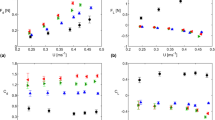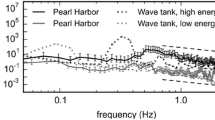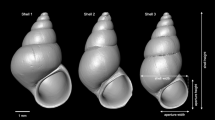Abstract
The intertidal zone is a turbulent landscape where organisms face numerous mechanical challenges from powerful waves. A model for understanding the solutions to these physical problems, the American horseshoe crab (Limulus polyphemus), is a marine arthropod that mates in the intertidal zone, where it must contend with strong ambient flows to maintain its orientation during locomotion and reproduction. Possible strategies to maintain position include either negative lift generation or the minimization of positive lift in flow. To quantify flow over the shell and the forces generated, we laser-scanned the 3D shape of a horseshoe crab, and the resulting digital reconstruction was used to 3D-print a physical model. We then recorded the movement of tracking particles around the shell model with high-speed video and analyzed the time-lapse series using particle image velocimetry (PIV). The velocity vector fields from PIV were used to validate numerical simulations performed with the immersed boundary (IB) method. IB simulations allowed us to resolve the forces acting on the shell, as well as the local three-dimensional flow velocities and pressures. Both IB simulations and PIV analysis of vorticity and velocity at a flow speed of 13 cm/s show negative lift for negative and zero angles of attack, and positive lift for positive angles of attack in a free-stream environment. In shear flow simulations, we found near-zero lift for all orientations tested. Because horseshoe crabs are likely to be found primarily at near-zero angles of attack, we suggest that this negative lift helps maintain the orientation of the crab during locomotion and mating. This study provides a preliminary foundation for assessing the relationship between documented morphological variation and potential environmental variation for distinct populations of horseshoe crabs along the Atlantic Coast. It also motivates future studies which could consider the stability of the horseshoe crab in unsteady, oscillating flows.
















Similar content being viewed by others
References
Bell EC, Gosline JM (1997) Strategies for life in flow: tenacity, morphometry, and probability of dislodgment of two mytilus species. Mar Ecol Prog Ser 159:197–208
Bhalla APS, Bale R, Griffith BE, Patankar NA (2013) A unified mathematical framework and an adaptive numerical method for fluid-structure interaction with rigid, deforming, and elastic bodies. J Comput Phys 250:446–476
Bill RG, Herrnkind WF (1976) Drag reduction by formation movement in spiny lobsters. Science 193(4258):1146–1148
Blake R (1985) Crab carapace hydrodynamics. J Zool 207(3):407–423
Brockmann HJ (1990) Mating behavior of horseshoe crabs, limulus polyphemus. Behaviour 114(1):206–220
Cignoni P, Callieri M, Corsini M, Dellepiane M, Ganovelli F, Ranzuglia G (2008) Meshlab: an open-source mesh processing tool. In: Eurographics Italian chapter conference, vol 2008, pp 129–136
Denny M (1989) A limpet shell shape that reduces drag: laboratory demonstration of a hydrodynamic mechanism and an exploration of its effectiveness in nature. Can J Zool 67(9):2098–2106
Denny M (1991) Biology, natural selection and the prediction of maximal wave-induced forces. S Afr J Mar Sci 10(1):353–363
Denny MW (2000) Limits to optimization: fluid dynamics, adhesive strength and the evolution of shape in limpet shells. J Exp Biol 203(17):2603–2622
Denny MW, Gaines SD (1990) On the prediction of maximal intertidal wave forces. Limnol Oceanogr 35(1):1–15
Denny M, Gaylord B (1996) Why the urchin lost its spines: hydrodynamic forces and survivorship in three echinoids. J Exp Biol 199(3):717–729
Denny MW, Daniel TL, Koehl M (1985) Mechanical limits to size in wave-swept organisms. Ecol Monogr 55(1):69–102
Dietl J, Nascimento C, Alexander R (2000) Influence of ambient flow around the horseshoe crablimulus polyphemus on the distribution and orientation of selected epizoans. Estuaries 23(4):509–520
Fauci LJ, Peskin CS (1988) A computational model of aquatic animal locomotion. J Comput Phys 77(1):85–108
Fish FE, Schreiber CM, Moored KW, Liu G, Dong H, Bart-Smith H (2016) Hydrodynamic performance of aquatic flapping: efficiency of underwater flight in the manta. Aerospace 3(3):20
Fisher D (1975) Swimming and burrowing in limulus and mesolimulus. Fossils Strata 4:281–290
Fisher DC (1977) Functional significance of spines in the pennsylvanian horseshoe crab euproops danae. Paleobiology 3(2):175–195
Griffith B (2014) An adaptive and distributed-memory parallel implementation of the immersed boundary (ib) method [cited October 21, 2014]. https://github.com/IBAMR/IBAMR
Griffith BE (2009) An accurate and efficient method for the incompressible navier-stokes equations using the projection method as a preconditioner. J Comput Phys 228(20):7565–7595
Griffith BE, Luo X (2017) Hybrid finite difference/finite element immersed boundary method. Int J Numer Methods Biomed Eng 33(12):e2888
Hamlet C, Santhanakrishnan A, Miller LA (2011) A numerical study of the effects of bell pulsation dynamics and oral arms on the exchange currents generated by the upside-down jellyfish cassiopea xamachana. J Exp Biol 214(11):1911–1921
Hamlet C, Fauci LJ, Tytell ED (2015) The effect of intrinsic muscular nonlinearities on the energetics of locomotion in a computational model of an anguilliform swimmer. J Theor Biol 385:119–129
Hamlet CL, Hoffman KA, Tytell ED, Fauci LJ (2018) The role of curvature feedback in the energetics and dynamics of lamprey swimming: a closed-loop model. PLoS Comput Biol 14(8):e1006324
Herschlag G, Miller L (2011) Reynolds number limits for jet propulsion: a numerical study of simplified jellyfish. J Theor Biol 285(1):84–95
Hoover A, Miller L (2015) A numerical study of the benefits of driving jellyfish bells at their natural frequency. J Theor Biol 374:13–25
Hoover AP, Griffith BE, Miller LA (2017) Quantifying performance in the medusan mechanospace with an actively swimming three-dimensional jellyfish model. J Fluid Mech 813:1112–1155
Hoover AP, Cortez R, Tytell ED, Fauci LJ (2018) Swimming performance, resonance and shape evolution in heaving flexible panels. J Fluid Mech 847:386–416
Hoover A, Porras A, Miller L, Pump or coast, Under review
Jacklyn P, Ritz D (1986) Hydrodynamics of swimming in scyllarid lobsters. J Exp Mar Biol Ecol 101(1–2):85–99
Jones S, Laurenza R, Hedrick TL, Griffith BE, Miller LA (2015) Lift vs. drag based mechanisms for vertical force production in the smallest flying insects. J Theor Biol 384:105–120
Krummel G, Kaipa KN, Gupta SK (2014) A horseshoe crab inspired surf zone robot with righting capabilities. In: ASME 2014 international design engineering technical conferences and computers and information in engineering conference, American Society of Mechanical Engineers, pp V05AT08A010–V05AT08A010
Martinez MM (1996) Issues for aquatic pedestrian locomotion. Am Zool 36(6):619–627
Martinez MM (2001) Running in the surf: hydrodynamics of the shore crab grapsus tenuicrustatus. J Exp Biol 204(17):3097–3112
Maude SH, Williams DD (1983) Behavior of crayfish in water currents: hydrodynamics of eight species with reference to their distribution patterns in southern ontario. Can J Fish Aquat Sci 40(1):68–77
Miller LA, Peskin CS (2004) When vortices stick: an aerodynamic transition in tiny insect flight. J Exp Biol 207(17):3073–3088
Miller LA, Peskin CS (2005) A computational fluid dynamics of ’clap and fling’ in the smallest insects. J Exp Biol 208(2):195–212
Miller LA, Peskin CS (2009) Flexible clap and fling in tiny insect flight. J Exp Biol 212(19):3076–3090
Miller LA, Santhanakrishnan A, Jones S, Hamlet C, Mertens K, Zhu L (2012) Reconfiguration and the reduction of vortex-induced vibrations in broad leaves. J Exp Biol 215(15):2716–2727
Mittal R, Iaccarino G (2005) Immersed boundary methods. Ann Rev Fluid Mech 37:239–261
Penn D, Brockmann HJ (1995) Age-biased stranding and righting in male horseshoe crabs, limulus polyphemus. Anim Behav 49(6):1531–1539
Peskin CS (1977) Numerical analysis of blood flow in the heart. J Comput Phys 25(3):220–252
Peskin CS (2002) The immersed boundary method. Acta Numer 11:479–517
Pierce JC, Tan G, Gaffney PM (2000) Delaware bay and chesapeake bay populations of the horseshoe crablimulus polyphemus are genetically distinct. Estuaries 23(5):690–698
Pond CM (1975) The role of the ‘walking legs’ in aquatic and terrestrial locomotion of the crayfish austropotamobius pallipes (lereboullet). J Exp Biol 62(2):447–454
Riska B (1981) Morphological variation in the horseshoe crab limulus polyphemus. Evolution 35(4):647–658
Saunders NC, Kessler LG, Avise JC (1986) Genetic variation and geographic differentiation in mitochondrial dna of the horseshoe crab, limulus polyphemus. Genetics 112(3):613–627
Sekiguchi K, Shuster C N (2009) Limits on the global distribution of horseshoe crabs (limulacea): lessons learned from two lifetimes of observations: Asia and America. In: Biology and conservation of Horseshoe crabs, Springer, pp 5–24
Selander RK, Yang SY, Lewontin RC, Johnson WE (1970) Genetic variation in the horseshoe crab (limulus polyphemus), a phylogenetic “relic”. Evolution 24(2):402–414
Stoermer L (1952) Phylogeny and taxonomy of fossil horseshoe crabs. J Paleontol 26(4):630–640
Trussell GC (1997) Phenotypic plasticity in the foot size of an intertidal snail. Ecology 78(4):1033–1048
Tytell ED, Hsu C-Y, Williams TL, Cohen AH, Fauci LJ (2010) Interactions between internal forces, body stiffness, and fluid environment in a neuromechanical model of lamprey swimming. Proc Nat Acad Sci 107(46):19832–19837
Tytell ED, Leftwich MC, Hsu C-Y, Griffith BE, Cohen AH, Smits AJ, Hamlet C, Fauci LJ (2016) Role of body stiffness in undulatory swimming: insights from robotic and computational models. Phys Rev Fluids 1(7):073202
Vosatka E (1970) Observations on the swimming, righting, and burrowing movements of young horseshoe crabs, limulus polyphemus. Ohio J Sci 70:276–283
Walls EA, Berkson J, Smith SA (2002) The horseshoe crab, limulus polyphemus: 200 million years of existence, 100 years of study. Rev Fish Sci 10(1):39–73
Webb PW (1989) Station-holding by three species of benthic fishes. J Exp Biol 145(1):303–320
Weissenberger J, Spatz H-C, Emanns A, Schwoerbel J (1991) Measurement of lift and drag forces in the m n range experienced by benthic arthropods at flow velocities below 1.2 ms- 1. Freshw Biol 25(1):21–31
Zaldívar-Rae J, Sapién-Silva RE, Rosales-Raya M, Brockmann HJ (2009) American horseshoe crabs, limulus polyphemus, in Mexico: open possibilities. In: Biology and conservation of horseshoe crabs, Springer pp. 97–113
Zerihan J, Zhang X (2000) Aerodynamics of a single element wing in ground effect. J Aircr 37(6):1058–1064
Zhang X, Toet W, Zerihan J (2006) Ground effect aerodynamics of race cars. Appl Mech Rev 59(1):33–49
Zhang C, Guy RD, Mulloney B, Zhang Q, Lewis TJ (2014) Neural mechanism of optimal limb coordination in crustacean swimming. Proc Nat Acad Sci 111(38):13840–13845
Acknowledgements
We would like to thank Brad Erickson and Jonathan Rader for help with laser scanning and 3D-reconstruction, and Miles Hackett for help with experiments. Additionally, we would like to thank the UNC Office of Undergraduate Research and the William W. and Ida W. Taylor Foundation for funding. This work was also supported by NSF DMS Grant #1151478 (to L.A.M.).
Author information
Authors and Affiliations
Corresponding author
Additional information
Publisher's Note
Springer Nature remains neutral with regard to jurisdictional claims in published maps and institutional affiliations.
Rights and permissions
About this article
Cite this article
Davis, A.L., Hoover, A.P. & Miller, L.A. Lift and Drag Acting on the Shell of the American Horseshoe Crab (Limulus polyphemus). Bull Math Biol 81, 3803–3822 (2019). https://doi.org/10.1007/s11538-019-00657-2
Received:
Accepted:
Published:
Issue Date:
DOI: https://doi.org/10.1007/s11538-019-00657-2




